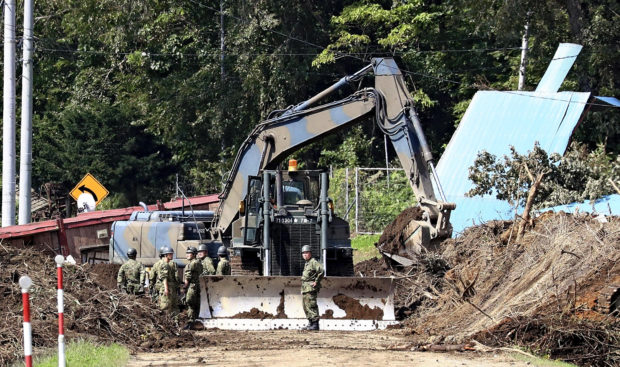
The Japan News/Asia News Network Photo
SAPPORO — Accommodation reservations for at least 500,000 people have been canceled in Hokkaido since a powerful earthquake struck the prefecture on Sept. 6, The Yomiuri Shimbun has learned.
A clearer picture of the financial cost of the earthquake is also emerging. Damage to roads, agricultural facilities and other infrastructure in the town of Atsuma, where the earthquake triggered huge landslides, has risen to about ¥15.7 billion ($140 million).
Distribution networks and other services are steadily resuming, but the severity of the damage caused by the earthquake, which registered the highest level on the Japanese seismic intensity scale of 7, is becoming apparent.
According to the Japan Ryokan and Hotel Association’s Hokkaido branch, the cancellation of accommodation for 500,000 people will have an economic impact of ¥10 billion. This figure is expected to increase as the branch collects more data from accommodation facilities. A flurry of events in Hokkaido have been canceled or shortened, which will sting Hokkaido’s economy during the autumn tourism season.
The Jozankei Tourist Association in Minami Ward, Sapporo, said hotels and other accommodation facilities in the hot spring district of Jozankei were hardly damaged by the earthquake, but at least 30,000 people had canceled stays there, mainly ones scheduled for this month.
According to the Hakodate Hotel Inn Cooperative, cancellations at facilities in Hakodate will have an impact of more than ¥2 billion.
The association’s Hokkaido branch is calling on relevant organizations to carry out campaigns targeting overseas visitors to dispel harmful misconceptions about the earthquake and its aftermath.
According to calculations by the Atsuma municipal government, damage to the town’s roads, rivers, agricultural facilities and other infrastructure had climbed to about ¥15.7 billion as of Thursday. As this was an interim tally, the town expects the figure to rise.
The Sapporo city government estimated damage to its public facilities, mainly roads, would top ¥10 billion.
Liquefaction reportedly destroyed at least 10 houses in Kiyota Ward, Sapporo. Damage from liquefaction also has been confirmed in the city’s Higashi Ward and the cities of Ebetsu, Kitahiroshima and Tomakomai.
Hokkaido’s rail and distribution networks are steadily being restored. According to Hokkaido Railway Co., limited express trains linking Sapporo with Obihiro and Kushiro resumed Friday. All limited express trains on lines in Hokkaido are now operating.
With the restoration of operations of railway tracks on local lines, Japan Freight Railway Co. is expected to resume freight train operations on all sections as soon as Sept. 22.
Marine transport also is getting back on its feet. Tomakomai Port, which is one of the nation’s ports with the largest volume of freight handled, briefly was unable to load and unload freight because power cuts rendered its large cranes unusable. Loading operations at the port had been almost fully restored by Thursday.
Hokkaido Electric Power Co. announced that the No. 1 unit at its Kyogoku pumped hydroelectric power plant in the town of Kyogoku was restarted on Thursday evening. The unit, which has an output of 200,000 kilowatts, had been shut down due to an equipment malfunction. The No. 2 unit, which also has an output of 200,000 kilowatts, was expected to come online on Friday.
Almost the whole of Hokkaido was hit by blackouts after the earthquake, leaving about 2.95 million households without electricity. As of 8 p.m. Thursday, just 144 households were still without power.